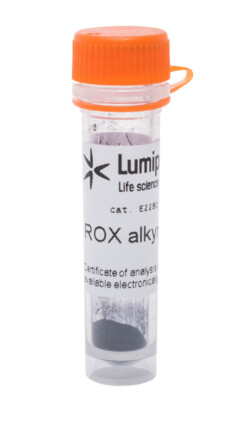LumiTracker® Mito Red CMXRos
| Cat. # | Quantity | Price | Lead time | Buy this product |
|---|---|---|---|---|
| 2251-50ug | 50 ug |
$12
|
in stock | |
| 2251-500ug | 500 ug |
$140
|
in stock |

LumiTracker Mito Red CMXRos is a cationic, red-fluorescent dye for staining active mitochondria in live cells. CMXRos is a hydrophobic compound that passively diffuses across the plasma membrane and selectively accumulates in active mitochondria based on their membrane potential. LumiTracker Mito Red CMXRos is compatible with aldehyde fixation. This dye is useful to indicate cell health as well as for mitochondria localization.
Ros in the name of this product stands for rosamine and has nothing to do with the detection of reactive oxygen species (ROS).
Absorption and emission spectra of Mito Red CMXRos

Recommended protocol
Calculator
Customers also purchased with this product
General properties
| Appearance: | dark green crystals |
| Molecular weight: | 531.53 |
| CAS number: | 167095-09-2 |
| Molecular formula: | C32H32Cl2N2O |
| Solubility: | DCM, DMF, methanol |
| Quality control: | NMR 1H and HPLC-MS (95+%) |
| Storage conditions: | 24 months after receival at -20°C in the dark. Transportation: at room temperature for up to 3 weeks. Desiccate. |
| MSDS: | Download |
| Product specifications |
Spectral properties
| Excitation/absorption maximum, nm: | 581 |
| ε, L⋅mol−1⋅cm−1: | 101000 |
| Emission maximum, nm: | 600 |
| Fluorescence quantum yield: | 0.91 |
Product citations
- Thi Duy Ngoc, N.; Yurchenko, E. A.; Thi Hoai Trinh, P.; Menchinskaya, E. S.; Thi Dieu, T. V.; Savagina, A. D.; Minin, A.; Thinh, P. D.; Khanh, H. H. N.; Thi Thanh Van, T.; Yurchenko, A. N. Secondary Metabolites of Vietnamese Marine Fungus Penicillium Chermesinum 2104NT-1.3 and Their Cardioprotective Activity. Regional Studies in Marine Science, 2025, 81, 104003. doi: 10.1016/j.rsma.2024.104003
- Aitova, A.; Scherbina, S.; Berezhnoy, A.; Slotvitsky, M.; Tsvelaya, V.; Sergeeva, T.; Turchaninova, E.; Rybkina, E.; Bakumenko, S.; Sidorov, I.; Popov, M.A.; Dontsov, V.; Agafonov, E.G.; Efimov, A.E.; Agapov, I.; Zybin, D.; Shumakov, D.; Agladze, K. Novel Molecular Vehicle-Based Approach for Cardiac Cell Transplantation Leads to Rapid Electromechanical Graft–Host Coupling. International Journal of Molecular Sciences, 2023, 24(12), 10406. doi: 10.3390/ijms241210406

























 $
$ 
